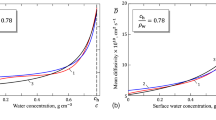Abstract
A skin–air model is developed to model the water barrier function of skin. The skin model is a porous solid saturated with a monovalent salt solution. The air model is a vapor diffusion model in non-moving air. In vivo measurements of water loss from human skin under varying ambient conditions are used to validate the model.
Similar content being viewed by others
References
Anderson, R., Cassidy, J., Hansen, J. and Yellin, W.: 1973, Hydration of stratum corneum, Biopolym. 12, 2789–2802.
de Borst, R., Kusters, G., Nauta, P. and Witte, F. D.: 1985, DIANA - A comprehensive, but flexible finite element system, In: C. Brebbia (ed.), Finite Element Systems: A Handbook, Springer Verlag, Berlin, New York and Tokyo.
DIANA: 1996, DIANA Finite Element Analysis: User's Manual, TNO Building and Construction Research, Delft, The Netherlands.
El-Shimi, A. and Princen, H.: 1978, Water vapor sorption and desorption behavior of some keratins, Colloid Polym. Sci. 256, 105–114.
Fatt, I.: 1968, Dynamics of water transport in the corneal stroma, Exp. Eye Res. 7, 402–412.
Guyton, A. and Hall, J.: 1996, Textbook of Medical Physiology,W.B. Saunders Company, New York.
Hansen, J. and Yellin, W.: 1972, NMR and infrared spectroscopic studies of stratum corneum hydration, In: H. Jellinek (ed.), Water Structure at the Water-Polymer Interface, Plenum Press, New York.
Hilliard Jr., P. and Dorogi, P.: 1989, Investigation of temperature and water activity effects on pig skin in vitro, J. Soc. Cosmet. Chem. 40, 1–20.
Holbrook, K. and Odland, G.: 1974, Regional differences in the thickness (cell layers of the human stratum corneum: an ultrastructural analysis, J. Invest. Dermatol. 62, 415–422.
Huyghe, J. and Janssen, J.: 1997, Quadriphasic mechanics of swelling incompressible porous media, Int. J. Eng. Sci. 35, 793–802.
Kemenade, P.: 1998, Water and ion transport through the skin, PhD Thesis, Eindhoven University of Technology, The Netherlands.
Lai, W., Hou, J. and Mow, V.: 1991, A triphasic theory for the swelling and deformation behaviors of articular cartilage, J. Biomech. Eng. 113, 245–258.
Langer, A.: 1861, Zur Anatomie und Physiologie der Haut. 1. Uber die Spaltbarkeit der Cutis, S.B. Akad. Wien 44, 19–46.
Mackie, J. and Meares, P.: 1955, Diffusion of electrolytes in cation exchange resin, Proc. Res. Soc. London Der. A 232, 498.
Maroudas, A.: 1975, Biophysical chemistry of cartilaginous tissues with special reference to solute and fluid transport, Biorheol. 12, 232–248.
Marshall, T.: 1988, Soil Physics, 2nd edn., Cambridge University Press.
Nachemson, A.: 1981, Disc pressure measurements, Spine 6, 93–97.
Nitao, J. and Bear, J.: 1996, Potentials and their role in transport in porous media, Water Resour. Res. 32(2), 225–250.
Oomens, C.: 1985, A mixture approach to the mechanics of skin and subcutis, PhD Thesis, University of Twente.
Oomens, C., Campen, D. V. and Grootenboer, H.: 1987, A mixture approach to the mechanics of skin, J. Biomech. 20(9), 877–885.
Oomens, C., de Heus, H., Huyghe, J., Nelissen, L. and Janssen, J.: 1995, Validation of the triphasic mixture theory for a mimic of intervertebral disc tissue, Biomimetics 3, 171–185.
Park, A. and Baddiel, C.: 1972, Rheology of stratum corneum-I: a molecular interpretation of the stress-strain curve, J. Soc. Cosmet. Chem. 23, 3–12.
Pikal, M. and Shah, S.: 1990, Transport mechanisms in iontophoresis. III. An experimental study of the contributions of electro-osmotic flow and permeability change in transport of solutes, Pharm. Res. 7(3), 222–229.
Snijders, H., Huyghe, J. and Janssen, J.: 1995, Triphasic finite element model for swelling porous media, Int. J. Num. Meth. Fluids 20, 1039–1046.
Snijders, J.: 1994, The triphasic mechanics of the intervertebral disc - a theoretical, numerical and experimental analysis, PhD Thesis, University of Limburg, Maastricht, The Netherlands.
Spencer, T., Linamen, C., Akers, W. and Jones, H.: 1975, Temperature dependence of water content of stratum corneum, Br. J. Dermatol. 93, 159–164.
Swabb, E., Wei, J. and Gullino, P.: 1974, Diffusion and convection in normal and neoplastic tissues, Cancer Res. 34, 2814–2822.
Warner, R., Meyers, M. and Taylor, D.: 1988, Electron probe analysis of human skin: determination of the water concentration profile, J. Invest. Dermatol. 90, 218–224.
Whitton, J. and Everall, J.: 1973, The thickness of the epidermis, Br. J. Dermatol. 89, 467–476.
Author information
Authors and Affiliations
Rights and permissions
About this article
Cite this article
van Kemenade, P.M., Huyghe, J.M. & Douven, L.F.A. Triphasic FE Modeling of the Skin Water Barrier. Transport in Porous Media 50, 93–109 (2003). https://doi.org/10.1023/A:1020680811437
Issue Date:
DOI: https://doi.org/10.1023/A:1020680811437




